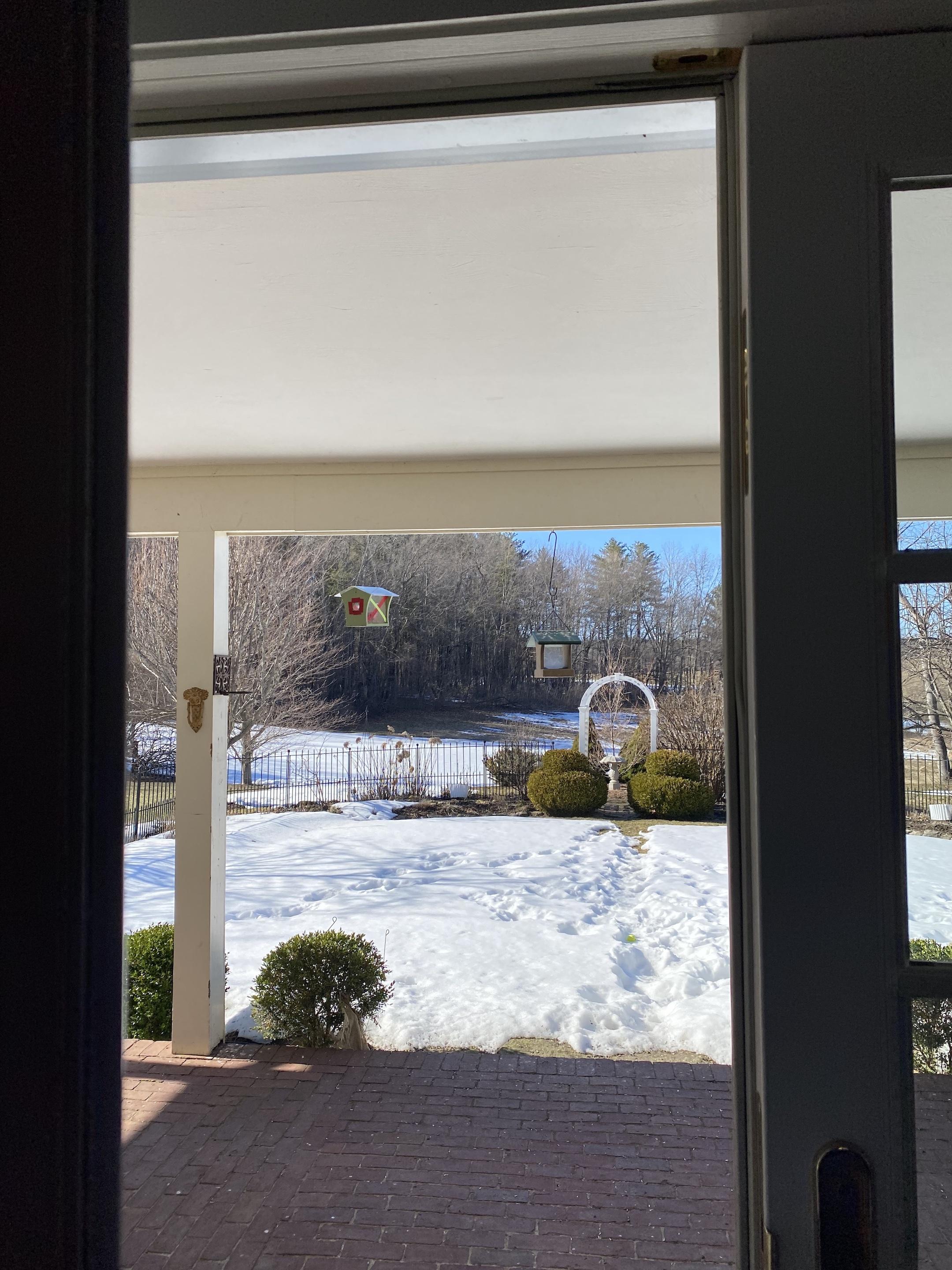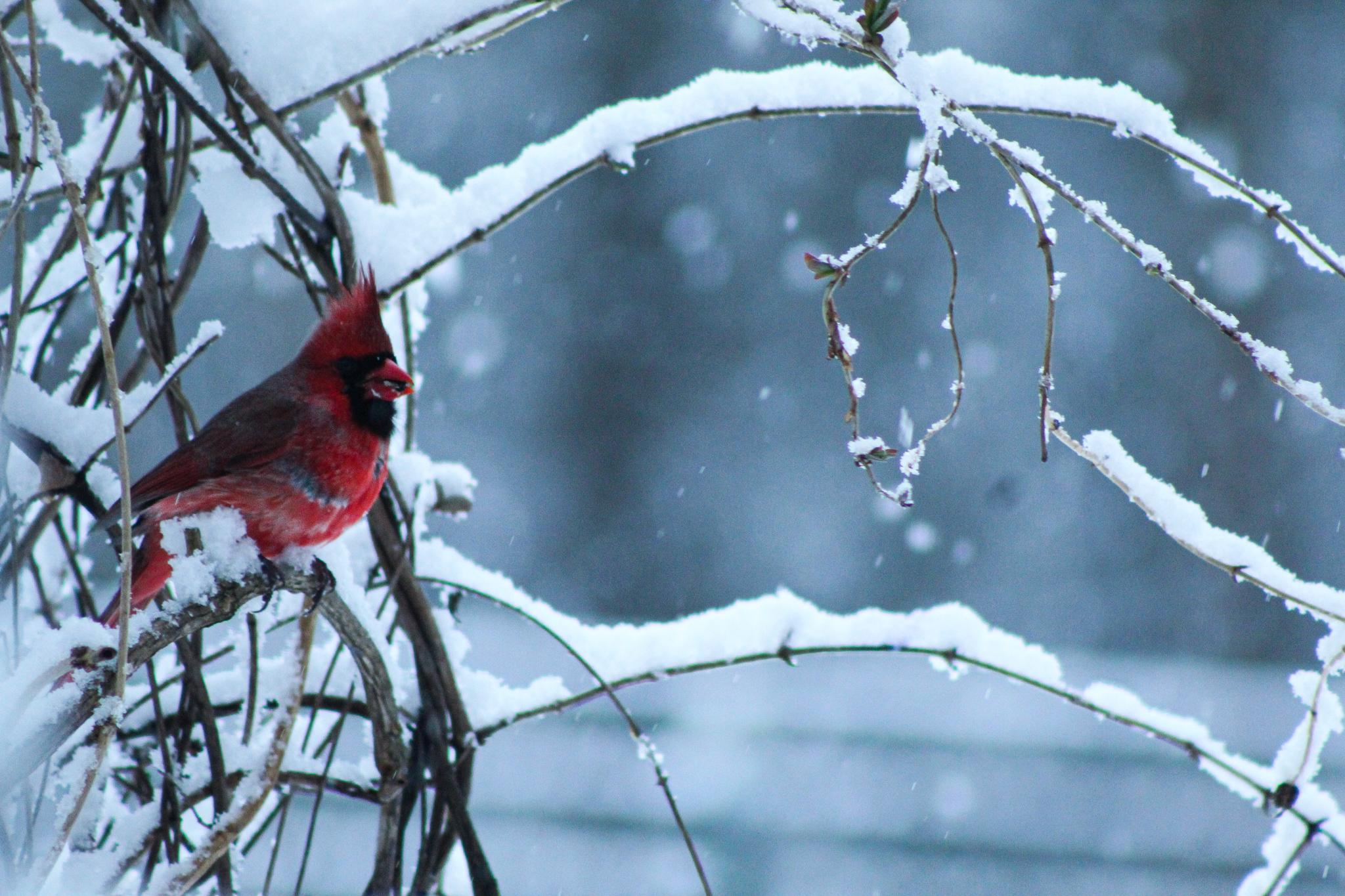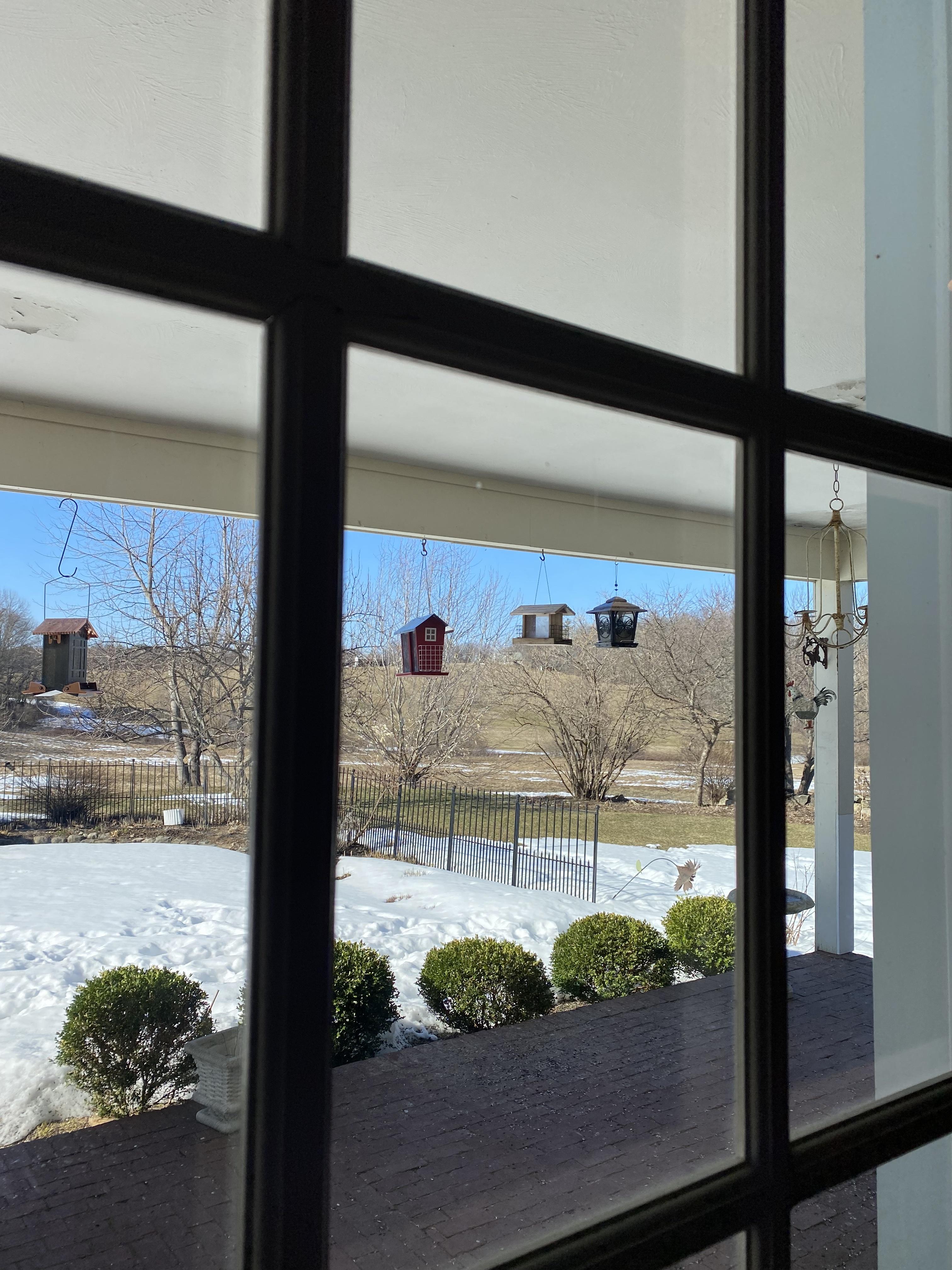- Tags:
- Wildlife,
- Forest Journal

The view from Sophie's doorway, where she often sees birds and other wild creatures outside. (Photo: Sophie Oehler)
Last weekend, I opened the door to find a cardinal lying dead on the porch, its neck broken and its feet tucked up into its matted, feathered chest.
Cardinals are frequent visitors to my mother’s bird feeder. For me, they’ve always symbolized the dawn of winter, their red plumage a cheery respite from the blank and bleary landscape of a snowy New England scene.

My roommate in college, spiritual as the day is long, believed the birds were special messages from his ancestors.
“When a cardinal appears, an angel is near!” he would quip as we zipped into our parking lot in his grey Toyota, “Hey Grandma, I see you!”
His beliefs are shared by many cultures and spiritualities across the globe. Roman Catholic settlers actually named the cardinal after their sacred religious officials, since the birds’ scarlett feathers bore an uncanny similarity to the color of the holy mens’ robes, and the tufted crest of the cardinal’s head looks remarkably like the headdresses worn by the Catholic priests. As a result, cardinals became a sacred messenger from heaven in the eyes of New American settlers.
Members of the Cherokee Indigenous Tribe view the cardinal (or “redbird”) as the vessel that carries the souls of the deceased to the afterworld. To see a cardinal was an unwelcome shock, the foretelling of an impending death.
I thought about this as I watched a rosie pair in the crabapple tree outside my grandparents’ bedroom window — the male inching along the thin branch to huddle closer to his mate for protection in a March gale.
My grandfather sprawled in front of me. He was dying, slowly but surely, a somber and sedated slip into the unconscious. Nine of us sat around him, watching his flame flicker and ebb, waiting for the embers to fade into the ether. His kidneys had failed, his heart followed suit, and he was in the final process of what the hospice nurses kept calling “this journey,” as if he was preparing for a marathon, or a particularly grueling vacation. They really ought to just start calling it what it is.
A pair of mourning doves joined the cardinals in the crabapple.
When I was younger, I used to think they were “morning doves,” which made enough sense to me since they always seemed to be most active in the early mornings, right as my dad was pulling out of our driveway to drop us off at this very house before he left for work.
It wasn’t until later that I learned the true spelling of their name, so given for their plaintive and haunting cry. coooWOOO-ooo-ooooo--oooo. Their call is often mistaken for that of an owl’s, thanks to their similar throaty “whowho-ing.”
Last winter, a mourning dove collided with my grandmother’s glass doors but miraculously survived. He lay in the snow, his head bent at an awkward angle, his beak bloody. I picked him up, put him in a box that Grandfather dug out of the garage and named him Walter.
Walter lasted two days in his Kirkland Special wine box before I decided I needed to call in the professionals. I took him to a bird sanctuary in Henniker (who I think was mildly amused that a common dove was being brought to their menagerie of birds of prey and Corvids) and left him in their care. I called the next day to inquire, and they informed me he had passed away overnight.
What I thought about then (admittedly for longer than necessary for a bird I found in the backyard) is would there be other doves that would miss Walter? Did he have a mate that would be waiting for his return? Did he have friends, a family, children? Did all those other birds even have the capacity to grieve him if they even existed?
Scientists have pondered this question for many years, studying avian mothers who lose their chicks and the behavior that follows the loss of the infant. Most mothers’ behavior could be defined as grief — nudging at the body with their beaks, vocalizing to their child, bonding together with the other females in the group — but according to the scientists, this behavior would have to be monitored for a long period of time, and sustain during that time in order to confirm that birds feel grief.
When our chicken coop got attacked by a fox several years ago, one of our chickens was killed. After her death, her sister completely distanced herself from the rest of the flock, stopped laying and lost interest in the bread scraps thrown her way from the porch. That seemed like sustained grieving behavior to me.
With all that in mind, I monitored the other mourning doves that came to the feeders after the loss of Walter. All of them attacked the sunflower seeds my grandfather had spread for them with great gusto, bickering amongst each other when a kernel was stolen from under their beak. They seemed to be doing anything but living up to their name.
On Sunday, March 19th, at 9:30 in the morning, my grandfather drew his last rattling breath and passed. He was 84 years old.
During those years, he lived in over ten countries, learned five languages, had three children and made many friends and admirers. He taught me how to draw, how to drive, and how to drink wine. He was always the first person to advocate for it being past the dog’s dinnertime. His favorite foods were mayonnaise and American cheese and munchkins from Dunkin Donuts (glazed, though certainly not all together).
He loved Kipling, “Oklahoma!”, and Winston Churchill. He loved books about the Civil War, watching Roger Federer on the Tennis Channel, and playing the New York Times’ sudoku. He loved his family. And he loved his birds.
As we sat in their dusty pink bedroom, waiting for the hospice nurse to come to confirm the death, my grandmother stared out onto their brick porch and sighed, “This is the first year he didn’t feed his birds. He was too weak to climb the ladder.”
Ever since I’ve known him, come winter, Grandfather could be found most mornings out on the porch in his heaviest coat, dumping sunflower seed into the birdfeeders that swung from the porch beams overhead. He bought special suet for the woodpeckers and was always trying to keep up to date on whatever feeder was claiming to be squirrel proof that year. He built birdhouses for my grandmother to hammer to fence posts and helped her in shoo-ing the English sparrows from any real estate that a bluebird might be hoping to occupy. If it were up to him, he would leave the feeders up all year, but would begrudgingly oblige when my father informed him it was time they came down, lest the bears discover the treasure trove.

About an hour before the funeral home came to collect Grandfather, a red tailed hawk appeared on one of the birdhouses at the edge of the meadowed property. He remained there while the hearse came and went. He stayed there while we dazedly ate turkey and cheese sandwiches. He was still there when we all came back from walking the dog on one of Grandfather’s favorite trails.
“Goodness, he’s still there!” my grandmother commented, peering through her binoculars, “Come on buddy, there’s lots of fat squirrel-ys up here to munch on.”
Birds are the only species on our planet that can fly. Some of them can swim underwater for brief periods of time. Thereby, they become the only creatures to be able to access all points of our world. Their bright colors remind us of our own colorful clothes and their harmonic voices inspire our own music. Birds are the closest and the furthest from our own human species. Of course they would come to represent our ancestors.
As we drove home from the house, a redtail swooped low over the road, almost brushing the roof of the car with its wing tips. I thought of Grandfather.
